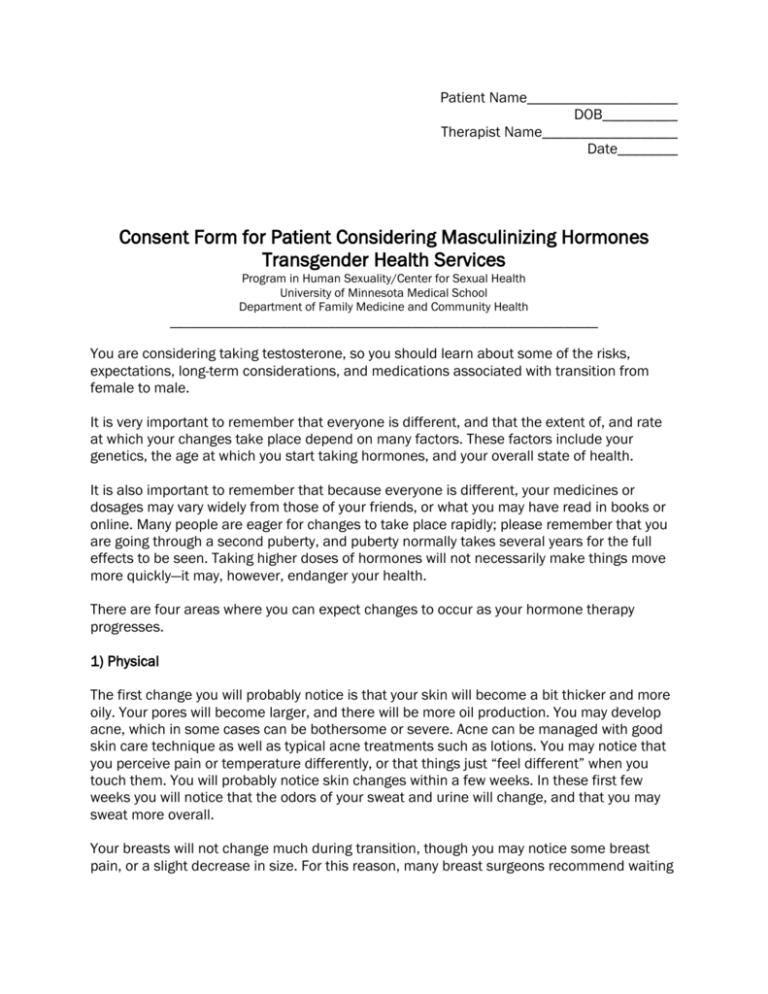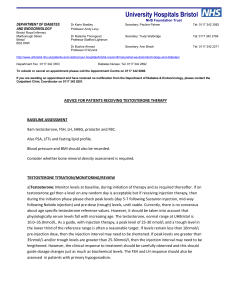
Patient Name____________________
DOB__________
Therapist Name__________________
Date________
Consent Form for Patient Considering Masculinizing Hormones
Transgender Health Services
Program in Human Sexuality/Center for Sexual Health
University of Minnesota Medical School
Department of Family Medicine and Community Health
______________________________________________________________
You are considering taking testosterone, so you should learn about some of the risks,
expectations, long-term considerations, and medications associated with transition from
female to male.
It is very important to remember that everyone is different, and that the extent of, and rate
at which your changes take place depend on many factors. These factors include your
genetics, the age at which you start taking hormones, and your overall state of health.
It is also important to remember that because everyone is different, your medicines or
dosages may vary widely from those of your friends, or what you may have read in books or
online. Many people are eager for changes to take place rapidly; please remember that you
are going through a second puberty, and puberty normally takes several years for the full
effects to be seen. Taking higher doses of hormones will not necessarily make things move
more quickly—it may, however, endanger your health.
There are four areas where you can expect changes to occur as your hormone therapy
progresses.
1) Physical
The first change you will probably notice is that your skin will become a bit thicker and more
oily. Your pores will become larger, and there will be more oil production. You may develop
acne, which in some cases can be bothersome or severe. Acne can be managed with good
skin care technique as well as typical acne treatments such as lotions. You may notice that
you perceive pain or temperature differently, or that things just “feel different” when you
touch them. You will probably notice skin changes within a few weeks. In these first few
weeks you will notice that the odors of your sweat and urine will change, and that you may
sweat more overall.
Your breasts will not change much during transition, though you may notice some breast
pain, or a slight decrease in size. For this reason, many breast surgeons recommend waiting
for at least six months after beginning testosterone therapy before having chest
reconstruction surgery.
Weight will begin to redistribute around your body. Fat will diminish somewhat around your
hips and thighs, and the fat under your skin throughout your body will become a bit thinner,
giving your arms and legs more muscle definition and a slightly rougher appearance.
Testosterone may cause you to gain fat around your abdomen (otherwise known as your
“gut”). Your muscle mass will increase significantly, as will your strength. However, in order
to maximize your development and maintain your health you should exercise 4-5 times a
week with 30 minutes/day of cardio/aerobics, as well as at least mild weight training.
Depending on your diet, lifestyle, genetics, and starting weight and muscle mass, you may
gain or lose weight once you begin HRT.
The fat under the skin in your face will decrease and shift around to give your eyes and face
in general a more angular appearance. Please note that your bone structure will likely not
change, though some people in their late teens or early twenties may see subtle bone
changes. The facial changes can take up to 2 years or more to see the final result.
The hair on your body, such as your chest, back and arms will increase in thickness, become
darker and will grow at a faster rate. You may expect to develop a pattern of body hair
similar to other men in your family. However, again please remember that everyone is
different, and that it can take up to 5 years or longer to see the final results. Most trans men
notice some degree of frontal scalp balding, mostly in the area of your temples. Depending
on your age and family history, you may develop thinning or even complete hair loss in a
male pattern baldness pattern.
Beards vary from person to person. Some people develop a thick beard quite rapidly; others
make take several years to do so, while others may never develop a full and thick beard.
This is a result of genetics and the age at which you start testosterone therapy. You might
notice that non-transgender men also have a varying degree of facial hair thickness, and a
varying age at which their beard fully developed.
Patient Initials_____
2) Emotional
Your overall emotional state may or may not change; this varies from person to person.
Puberty is a roller coaster of emotions, and the second puberty that you will experience
during your transition is no exception. You may find that you have access to a narrower
range of emotions or feelings, or have different interests, tastes or pastimes, or behave
differently in relationships with other people. While psychotherapy is not for everyone, most
people would benefit from a course of supportive psychotherapy while in transition to help
you explore these new thoughts and feelings, and get to know your new self.
Patient Initials_____
3) Sexual
Soon after beginning hormone treatment, you will likely notice a change in your libido. Quite
rapidly, your clitoris will begin to grow, and will become larger when you are aroused. You
may find that there are different sex acts or different parts of your body that bring you erotic
pleasure. Your orgasms will feel different, with perhaps more peak intensity, and more
focused on your genitals, as opposed to a whole body experience. It is recommended that
you explore and experiment with your new sexuality through masturbation, using sex toys,
and involve your sexual partner.
Patient Initials_____
4) Reproductive
You may notice at first that your periods become lighter, arrive later, or are shorter in
duration than previously. Some people will actually notice heavier or longer lasting periods
for a few cycles before they stop altogether.
Testosterone greatly reduces your ability to become pregnant. However, it does not
eliminate the risk of pregnancy completely. If you are on testosterone and remaining
sexually active with a non-transgender man, you should always continue to use a birth
control method to prevent unwanted pregnancy.
It is possible for transgender men to become pregnant while on testosterone. If you suspect
you may be pregnant, have a pregnancy test as soon as possible, so that your doctor can
stop your testosterone treatment, which may be dangerous to the fetus. If you want to
become pregnant, you must first stop your testosterone treatment and wait until your doctor
tells you that it is okay to begin trying to conceive. Your doctor may check your testosterone
levels before clearing you to begin efforts of conception.
Testosterone therapy may change the shape of your ovaries and make it more difficult for
them to release eggs. If this happens, you may need to use fertility drugs, or use techniques
such as in vitro fertilization in order to become pregnant. It is possible that after taking
testosterone, you may completely lose the ability to become pregnant. “Freezing” eggs is not
yet a realistic alternative for preserving your fertility.
After being on testosterone for some time, you may experience a small amount of spotting or
bleeding. This may occur if you miss a dose, or change your dosage. You should report any
bleeding or spotting to the doctor; in some cases, it must be followed up with an ultrasound
to be sure that you do not have a precancerous condition called “hyperplasia”.
The risk of developing hyperplasia while taking testosterone is not clear. It is usually
recommended that as long as you have a uterus, you are screened for hyperplasia once
every two years, even if you have not had any bleeding. There are two ways to do this. One is
to have an ultrasound performed. Another way is to take a hormone called progesterone for
10 days, after which you will have small period. This helps to “reset” your uterus and help
prevent hyperplasia. If you take 10 days of progesterone and do not have a period, you will
need an ultrasound as this may indicate that hyperplasia has developed.
Your risk of cervical cancer relates to your past and current sexual practices. Please note
that even people who have never had a penis in contact with their genitals may still contract
HPV infections. The HPV vaccine (Gardasil) can greatly reduce your risk of cervical cancer,
depending on the age at which you get the vaccine, and how many sexual partners you have
had before receiving the vaccine. Pap smears are generally recommended every two years;
more or less frequent pap smears may be recommended by the doctor, depending on your
sexual history and the results of your prior pap smears.
The risk of cancer of the ovaries may be slightly increased while on testosterone treatment.
Ovarian cancer is difficult to screen for, and most cases of ovarian cancer are discovered
after it is too late to be treated. A pelvic examination, where your doctor uses a gloved hand
to examine your vagina, uterus and ovaries is recommended every 1-2 years to help detect
this condition. Many experts recommend a full hysterectomy and bilateral salpingooopherectomy (removal of the uterus, ovaries, and fallopian tubes) within 5-10 years of
beginning testosterone treatment in order to minimize your cancer risk.
The risk of breast cancer while on testosterone treatment is not significantly increased.
However, there has not been enough research on this topic to be certain of the actual risk. It
is still important to receive periodic mammograms or other screening procedures as
recommended by your doctor. After breast removal surgery, there is still a small amount of
breast tissue left behind. It may be difficult to screen this small amount of tissue for breast
cancer, though there are almost no cases of breast cancer in transgender men after chest
reconstruction surgery.
Testosterone will change your overall health risk profile to that of a man. Your risk of heart
disease, diabetes, high blood pressure, and high cholesterol may go up, though these risks
may be less than a non-transgender man’s risks. Since men on average live about 5 years
less than women, you may be shortening your lifespan by several years by taking
testosterone. Since you do not have a prostate, you have no risk of prostate cancer and
there is no need to screen for this condition.
Testosterone can make your blood become too thick, which can cause a stroke, heart attack
or other conditions. Testosterone can cause your liver to work too hard, causing damage.
Your doctor will perform periodic tests of your blood count, cholesterol, kidney functions, and
liver functions, and a diabetes-screening test in order to closely monitor your therapy.
Testosterone levels do not need to be routinely checked, as they are expensive; however,
your doctor may choose to check them for a variety of reasons.
Some of the effects of hormone therapy are reversible if you stop taking testosterone. The
degree to which the effects can be reversed depends on how long you have been taking the
testosterone. Clitoral growth, facial hair growth, and male-pattern baldness are not
reversible.
If you have had your ovaries removed, it is important to remain on at least a low dose of
hormones post-op until at least age 50 years old (and perhaps beyond), to prevent a
weakening of the bones, otherwise known as osteoporosis.
Testosterone comes in several forms. Most transgender men begin using an injectable form
of testosterone, which is safe and effective. Some men chose to begin on a lower dose and
increase slowly, while others chose to begin at a standard dose. Both approaches have their
pros and cons, and you can discuss this with the doctor. Testosterone levels tend to be most
even when the injections are given weekly. There are also transdermal forms (patches, gels,
and creams) available. Most men will need to start with injections in order to see significant
changes, some may then change to one of the transdermal forms.
Taking more testosterone will not make your changes progress more quickly and can be
unsafe. Excess testosterone can be converted to estrogen, which can then increase your
risks of hyperplasia or cancer, as well as make you feel anxious or agitated, can harm your
liver, and can cause your cholesterol or blood count to get too high. It is important to be
patient and remember that puberty can take years to develop all of its changes.
I have reviewed the above information with my provider. I understand the foregoing
information about masculinizing hormone usage, and I hereby consent to the prescription
use of masculinizing hormones.
Patient________________________________________
Date_____________________
Therapist______________________________________
Date_____________________
* Adapted from: Primary Care Protocol for Transgender Patient Care, Center of Excellence for Transgender Health, University of California,
San Francisco, Department of Family and Community Medicine, April 2011










